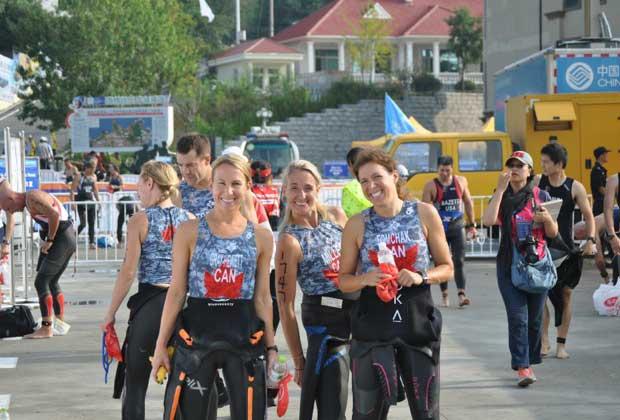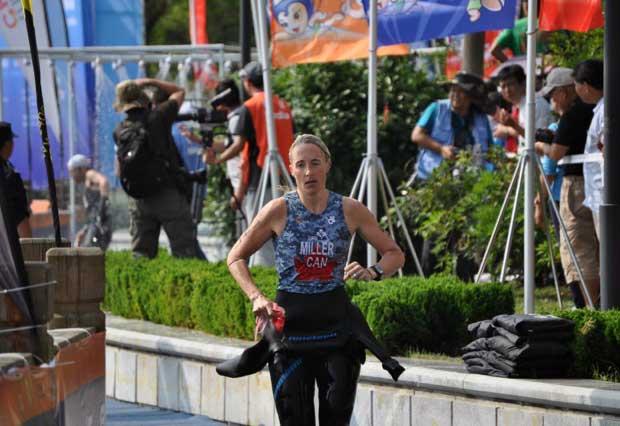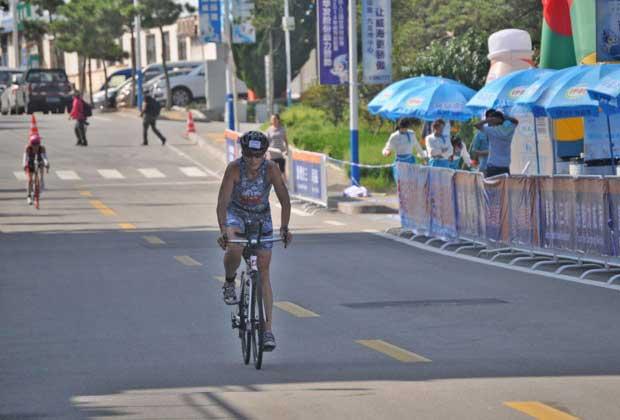What Happened at Weihai?
During a rough August, Julie Miller endured the ignominy of three disqualifications. Race officials decided that Ms. Miller did not complete the entire run course during both the 2013 and 2015 Ironman Canada events, and her performance at the 2014 Subaru Vancouver Triathlon was negated after the timing company reported widely variant times over the 4 loops of the bike course.
The focus is now on her women's 40-44 age group win at the 2014 Long Course World Championships in Weihai, China. Technology and reasoning similar to that used by officials scrutinizing her Ironman Canada races, combined with the testimony of several participant eyewitnesses, are used below to analyze Ms. Miller's performance in that race.

A case can be made for Julie Miller completing the entire Weihai course correctly and fairly, and that case is stated here. But many will not adopt this view, finding it difficult or impossible to reconcile data and testimony arguing in the opposite direction. This is presented as well.
Alan Ma, the ITU's technical delegate for the race in Weihai, referred inquiries about Ms. Miller's championship victory to the ITU's spokesperson Erin Greene. Ms. Greene re-referred to the technical committee chair Gergely Markus, who wrote that Ms. Miller's Weihai race, "will be on the agenda of the next Technical Committee meeting for further investigation."
While the ITU is not granting access to the timers or local race organizers at Weihai, the same kind of forensic reconstruction that race organizers used to disqualify Ms. Miller from two other Ironman races has been applied to the World Championship race in Weihai.
Images from photo streams viewable by the public often contain EXIF data, which include digital date and time stamps that help generate a timeline. The analysis here relies in part on this data. The technology and reasoning is identical to that used as the basis for disqualifying Ms. Miller from both Ironman Canada races. The one difference is in the nature of the cameras. In Ironman Canada, the photos came from FinisherPix cameras, but in the Weihai race the photos were shot by spectators and published in DropBox folders.
The time stamps on the photos show the relative differences between the positions of athletes on the course at various times. Photo streams from these cameras are of particular value, as their owners snapped shots of multiple racers passing by fixed spots throughout the race. This allows one analyzing the race to gauge the progress of these competitors relative to each other as the race progressed.
Official timing data from the Weihai race is variously reliable. Many bike and run splits are accurate or near it when compared to athletes' personal (i.e., Garmin) files from the race. The swim splits, less so. None of Ms. Miller's credited splits for any of the legs (as we shall see) comport with the data and eyewitness testimony.
The problem with the timing in Weihai began with the swim splits. Ms. Miller was given a swim time of 1:12:26. Time stamps from a camera that shot images of the swim start and exit place Julie Miller out of the water 1:06 into the race, and into T1 at about 1:07:27 of elapsed race time. Swim splits from other athletes are also suspect.
Why are swim splits at odds with what athletes swam, while bike and run splits shown on the results page are often close or correct? A possible explanation: Female athletes were originally told they were to leave in waves, but in the end, in what seems a hasty decision by the race starter (according to competitors' testimony), they left all at once, in the same wave. Maybe the timers were not apprised of this change. Because the ITU is not granting access to those directly associated with the race, we don't know.

Among long distance age group competitors, the undisputed star of the Canadian team to China was Tamasin Reno. She would go on to record the fastest time of all age group athletes in Weihai on her way to winning the women's 30-34 age group. She is, however, a notoriously average swimmer compared to her formidable land-based skills. She would exit the swim more than 4 minutes behind Ms. Miller, using time stamps as an unofficial "timing system."
Ms. Reno recollected that, "I passed Julie early in on the bike, maybe 10 minutes in, on the first loop, on a hill. Honestly I blew by her," and continues, "I had the fastest AG women's bike split of the day at around 3:45, so the amount of people passing me were very few."
The owner of one of these cameras shot while on a steep descent during the bike ride, near the finish of the first of three 40km loops of the bike course. That photo stream shows Ms. Miller trailing a number of her Canadian teammates at this point, in the neighborhood of two-and-a-half hours into the race (swim included). Canadian Colleen Gray Hewitt rode by this spot first, followed a minute later by Ms. Reno, then three Canadian men, and Ms. Miller about 6:45 behind Ms. Reno. Ms. Gray Hewitt, who won the female 45-49 AG in Weihai, had an almost 8-minute lead on Ms. Miller after the first lap of the bike leg despite exiting the water behind her.
The time stamps on these photos suggest that Ms. Reno made up the more-than-4 minute deficit on Ms. Miller in the first half of the first lap, and this comports with Ms. Reno's, "I passed Julie early in on the bike, maybe 10 minutes in, on the first loop."
Adding the deficit out of the water to the 6:45 lead after lap 1 of the bike loop, Tamasin Reno rode approximately 11:20 faster than Ms. Miller over the first lap of the 3-lap bike course, based on the photographic data. This time gap after lap 1 syncs with Ms. Reno's recollection of where on the first lap she passed Ms. Miller.
Ms. Reno said of her bike ride in Weihai that it was, "probably my best ride ever." One can understand her surprise when, "On the last giant hill on the third lap, near the end, I came upon Julie again. Initially I thought I was lapping her and that she was having a bad day. When I caught up to her she said 'Oh, I knew you'd catch me again.' It threw me as I was sure she hadn't back-passed me, but I always assumed it was my mistake and that I just missed seeing her."
Another time-stamped photo shows Ms. Miller exiting a tunnel during the bike leg only 1:20 down on Ms. Reno, after nearly 5 hours of racing, i.e., near the bike finish. This is congruent with Ms. Reno's account of passing her a second time, late into the bike leg.

Much has been made of the 1:23 half-marathon split listed for Ms. Miller. Photographic evidence and eyewitness testimony strongly suggest Ms. Miller did not run 1:23 in Weihai. Her official run split, found on the ITU's results page for this race, is simply wrong.
Once onto the run leg, Ms. Reno continued to gain. "One thing I can say for certain, though, is I was running a lot faster than Julie," said Ms. Reno. "The run course, as you can see, was four 5k loops with multiple out and backs, so you saw other people regularly. I did see Julie during the run, and at each point I saw her I had gotten further ahead."
Time-stamped photos show that by the time Ms. Miller was about 29 minutes into the run, she trailed Ms. Reno by about 5:30. Ms. Reno was credited with a 1:36 half-marathon run split by officials. This suggests that Ms. Miller, far from running a 1:23, was for the first third of the run leg, on a pace to run in the 1:40s or slower.
Mike Robertson was another member of Canada's age group worlds contingent in Weihai. "I witnessed [Ms. Miller's] run, ran with her, and passed her on my 1:46 run split. She did not pass me back and I saw her for most of the run falling farther back at each turn around."
I asked Mr. Robertson if he had any personal data to verify his run split. "My Garmin data and my splits were spot on."
If one stipulates to Mr. Robertson's testimony, this means Ms. Miller ran something slower than a 1:46 split. There is data to support this. Images of Ms. Miller after the run start, and again at the run finish, were taken 1:45:46 apart in time. According to this time-stamp data, she ran 1:45:46 plus whatever time had passed between the run start and the time this first photo was taken.
UK athlete Victoria Hill was officially placed 2nd in Weihai in the women's 40-44. "Julie had clearly crossed the line in front of me," reports Ms. Hill. "I knew I was catching her, there was no way she is a faster runner than me. At the finish, the results said I had won, which of course she challenged. She had crossed the line in front of me so I accepted that I had come in 2nd."
"When the results finally came out on the website, it showed that she had come off the bike after me and then ran a faster time than me. I always knew this was wrong, as I know for a fact no girl passed me on the run."
"At the time," Ms. Hill said, "I put it down to dodgy timings. My suspicions were raised again when I raced her in Sweden this year and her times were nothing of the standard she did in China!"
Ms. Hill finished 4th in the women's 40-44 in the Long Course Worlds in Sweden this year, and Ms. Miller 39th.
Jen Milton was another of the Canadian contingent, and recalled, "I started my first loop of the run and saw [Julie] maybe 3 of the loops almost in the same spot every time. I remember thinking she must be doing the same pace as me."
Jen Milton was officially credited with a 1:43:03 run in Weihai.
"On the third loop," continued Ms. Milton, "this girl went flying by me at a blistering pace, who I then saw at the finish line and it was Victoria [Hill]. Essentially what happened was I came to the finish line to find Julie speaking to the officials about who had finished first. The officials were certain that Victoria Hill had won, but Victoria agreed that Julie was already at the finish line. Julie was telling me that there was a problem with her timing chip on the swim."
In both of Ms. Miller's Ironman Canada disqualifications, her timing chip failed to record while crossing the run course timing wires.
Ms. Hill recalls that in Weihai, "The results were a debacle, it took ages for them to do our awards ceremony, and then it transpired that her chip had been lost or something went wrong with it."
Adam Leitch, a supporter of the UK team in Weihai, recalls, "It was the belief of pretty much everybody around that Victoria Hill had won that age group, only for Miller to claim her timing chip had gone missing. Miller was very vociferous in shouting her cause at the finish. What I found was a situation of utter confusion. To be perfectly honest, the officials there were struggling to work out what was going on."
There is no evidence that Ms. Miller failed to complete the run course properly. Photographic time-stamp data and multiple eyewitness accounts all agree that she ran a time equal to and probably slower than Mike Robertson's 1:46 run split, neutering any criticism of a 1:23 half-marathon split few believe she was capable of running.
This hasn't lessened the scrutiny of Ms. Miller's race. Her mortal – rather than superhuman – run split shifts the pressure onto the cycling performance she would have needed in order to win her age group in Weihai. For Julie Miller's bike ride to be proper and within the rules, how would it have transpired?
After losing 11 minutes on the first of 3 laps to Tamasin Reno, Ms. Miller would have thrown off her early slower pace to eventually overtake the steadily-riding, and very hard-riding, Ms. Reno. (Tamasin Reno's Garmin Connect data shows consistent power across all 3 laps of the bike course.) She would need to make up the 6:45 she was down to Ms. Reno at the end of lap 1 of the bike, overtake Ms. Reno without her noticing, and then Ms. Miller would eventually fade, to be overtaken again by Ms. Reno near the end of the bike segment.
(The raw analysis of just the time-stamp photographic data was performed by a party interested in the process and, along with eyewitness testimony, forms the basis for the time and speed conclusions drawn herein.)
Now that we know Ms. Miller's run was something slower than 1:46, is there any basis for doubting the legitimacy of Ms. Miller's swim and run legs in Weihai? None that we can see.
The case against Ms. Miller's proper completion of the entire course in Weihai comes down to this: Violent speed over the final 2 laps of the bike leg would have been required for her to (however briefly) overtake Tamasin Reno.
Is there a case that can be made in Ms. Miller's favor? Yes.
Let us assume that Julie Miller swam a 1:05, giving her the benefit of every second. The T1 splits for all athletes were about 5 minutes, and T2 splits were around 3 minutes. We know Ms. Miller ran slower than 1:46 based on much evidence. Let us say she ran a split of 1:48. She's credited with an overall finish time of 6:53. This backs us unto a bike split of 3:52.
Tamasin Reno's bike split was 3:45, the fastest of the day among all the age-group women. The fastest listed split in Ms. Miller's age group was a 4:06. Indeed, the second fastest split among all age group women was 3:55. This would make Ms. Miller's bike split the second fastest of the day, behind Ms. Reno. It is not out of the realm of human potential for a woman in the 40-44 age group to have biked a 3:52. This kind of bike prowess is not obvious in Julie Miller's race pedigree. Still, a 3:52 is not impossible.
Julie Miller was disqualified in Canada this year after running a 3:31 marathon – certainly not outside the realm of possibility. In her Vancouver DQ, her bike split was very fast, but not inhuman. Her bike ride in Weihai was very fast, but not inhuman. In all these cases, Julie Miller's performances throughout the entirety of a bike or run leg are not impossible performances – certainly not enough to warrant a disqualification. Ms. Miller's bad luck with timing chips does not help, but it is not the ultimate stumbling block. In the case of each race, for the narrative in her favor to prevail, it must overcome the very fast elapsed time of a discrete segment inside a bike or run leg.
How violent would the change of pace after lap 1 need to be, in order for Ms. Miller to overtake Tamasin Reno some distance prior to the end of the ride? Mathematics indicates the final two-thirds of Ms. Miller's bike leg would need to have been ridden at a pace no slower than the low-to-mid 3:30s, very possibly in the 3:20s. To place this in perspective, the two fastest pro women bike splits in Weihai were 3:21:27 and 3:24:34.


